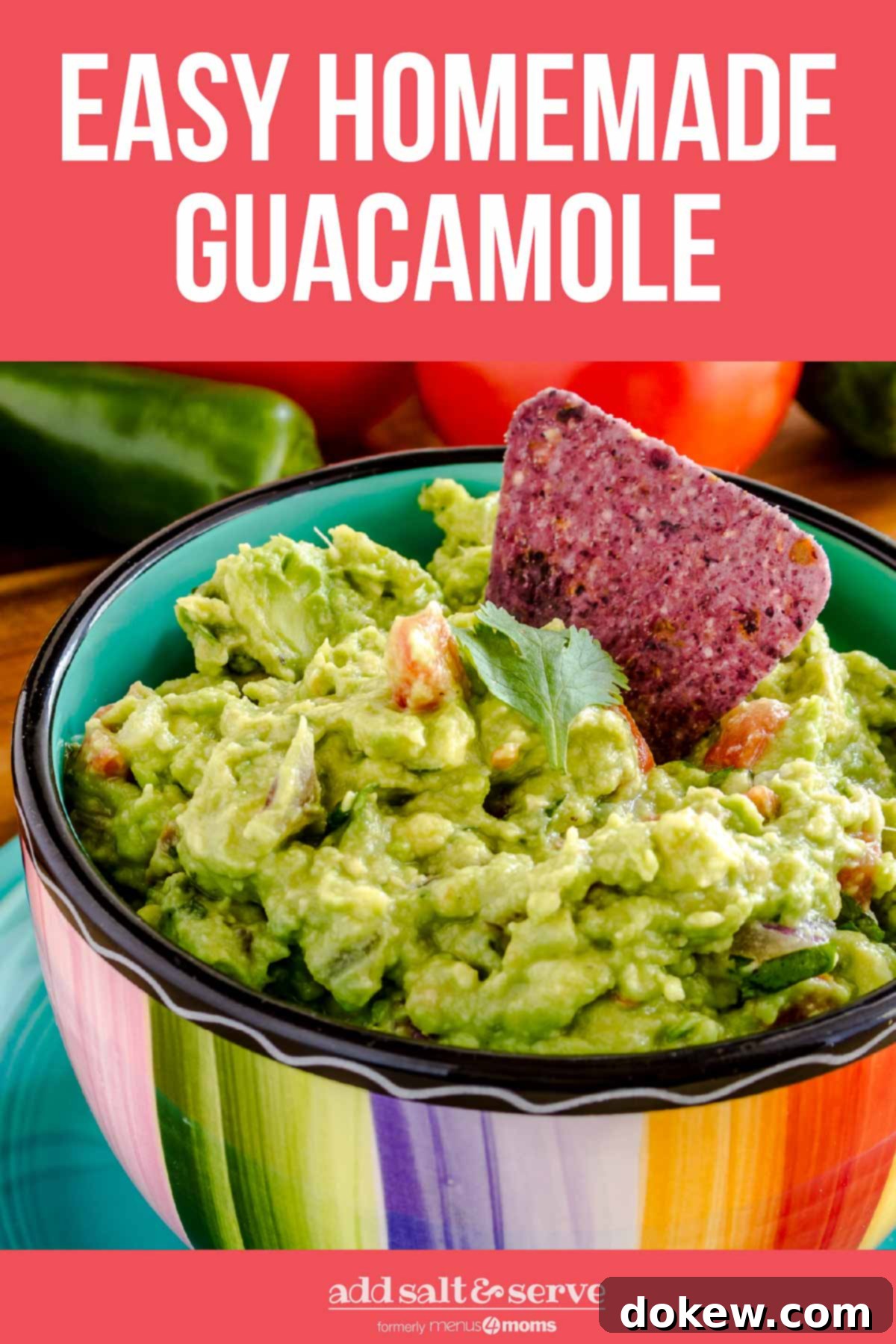Easy Homemade Guacamole: A Fresh, Flavorful, and Fast Recipe Guide
There’s nothing quite like the vibrant flavor and creamy texture of fresh homemade guacamole. This classic dip is surprisingly simple to prepare using just a handful of fresh ingredients, elevating any meal from ordinary to extraordinary. Whether you’re hosting a party, enjoying a casual game night, or simply looking for a healthy snack, our easy homemade guacamole recipe is a versatile crowd-pleaser. It’s perfect for enhancing the taste of your favorite tacos, nachos, tostadas, burritos, and more. Beyond its deliciousness, this recipe is naturally low-carb, gluten-free, and vegan, making it an ideal choice for diverse dietary needs and preferences. Forget about pre-made mixes; once you taste the difference that fresh ingredients make, you’ll never go back!
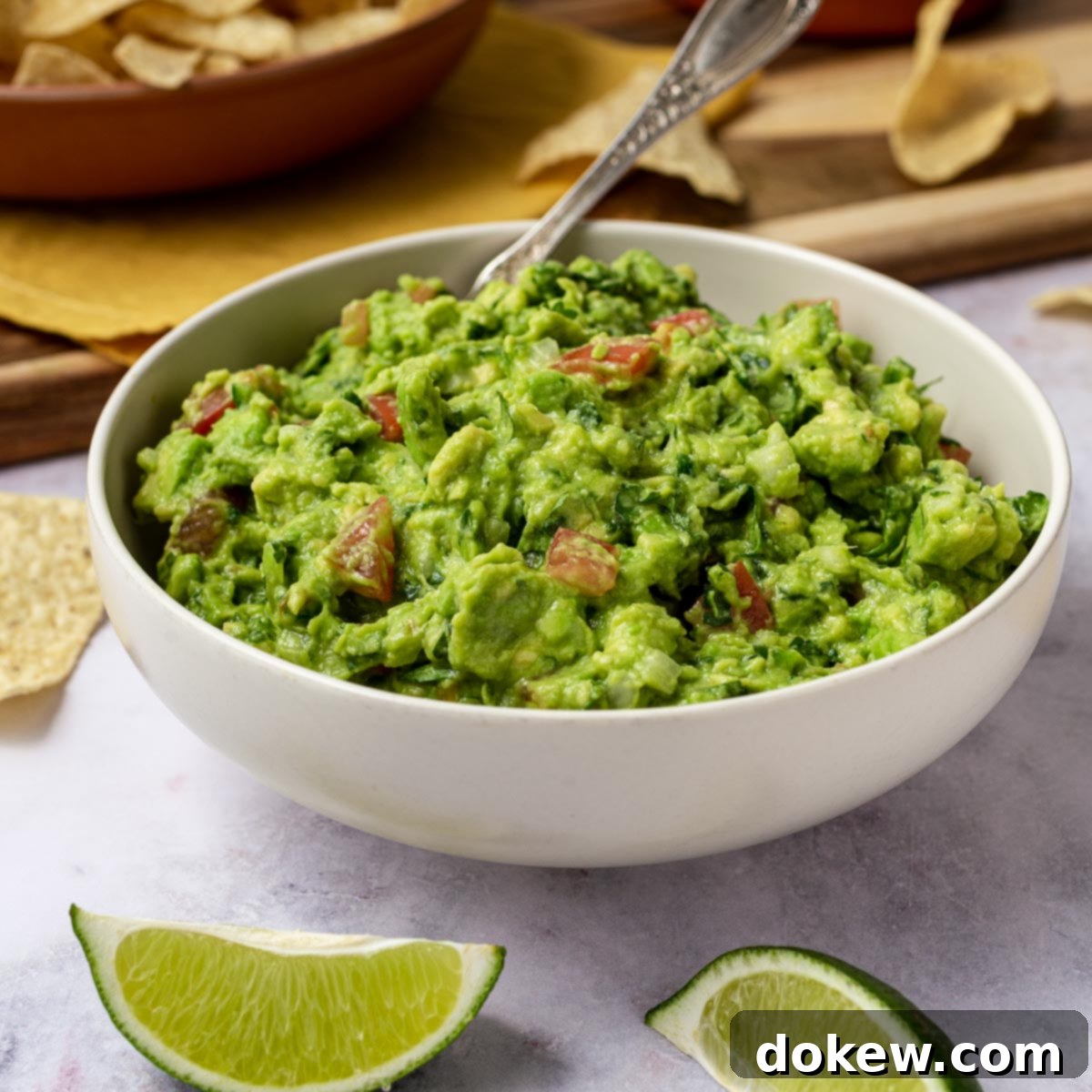
⏲️ Time Needed to Make Fresh Guacamole
One of the best aspects of making homemade guacamole is how quickly it comes together. This recipe requires minimal preparation and mixing time, typically taking only 10 to 15 minutes from start to finish. This makes it an ideal last-minute appetizer or a quick addition to your dinner spread. The most time-consuming part might be chopping your fresh vegetables and carefully selecting perfectly ripe avocados, but even these steps are swift and straightforward. You’ll be enjoying your creamy, zesty dip in no time!
❓ Homemade Guacamole FAQ
Absolutely, and it’s highly recommended! There is absolutely no need to use any kind of pre-packaged mix to make delicious homemade guacamole. In fact, relying on fresh, high-quality ingredients is the secret to an authentic and superior flavor. Guacamole mixes often contain artificial flavors, preservatives, and excessive sodium that detract from the natural richness of the avocado. By making it from scratch, you have complete control over the taste, ensuring a pure, vibrant flavor profile that perfectly complements the creamy avocado base. It’s also much healthier and more satisfying.
The beauty of authentic homemade guacamole lies in its simplicity and fresh ingredients. The core components are:
- Avocados: The star of the show, providing the creamy base.
- Chopped Onion: Adds a pungent, aromatic kick. Red onion or white onion can be used, depending on preference for intensity.
- Chopped Tomato: Introduces freshness, a slight sweetness, and a lovely textural contrast. Roma tomatoes are often preferred for their firm flesh and fewer seeds.
- Seeded and Diced Jalapeño Pepper: Provides a touch of heat. You can adjust the quantity or remove more seeds to control the spice level. For more heat, you can leave some seeds in, or even use a serrano pepper.
- Salt: Essential for enhancing all the other flavors. Kosher or sea salt is recommended.
- Lime (Juice plus Zest): Crucial for brightness, acidity, and preventing browning. The zest adds an extra layer of citrus aroma.
- Chopped Fresh Cilantro: Offers a distinct herbaceous and fresh note that is quintessential to guacamole. If you’re one of those who find cilantro tastes like soap, you can omit it or substitute with finely chopped parsley.
These ingredients combine to create a balanced, flavorful, and truly authentic guacamole experience.
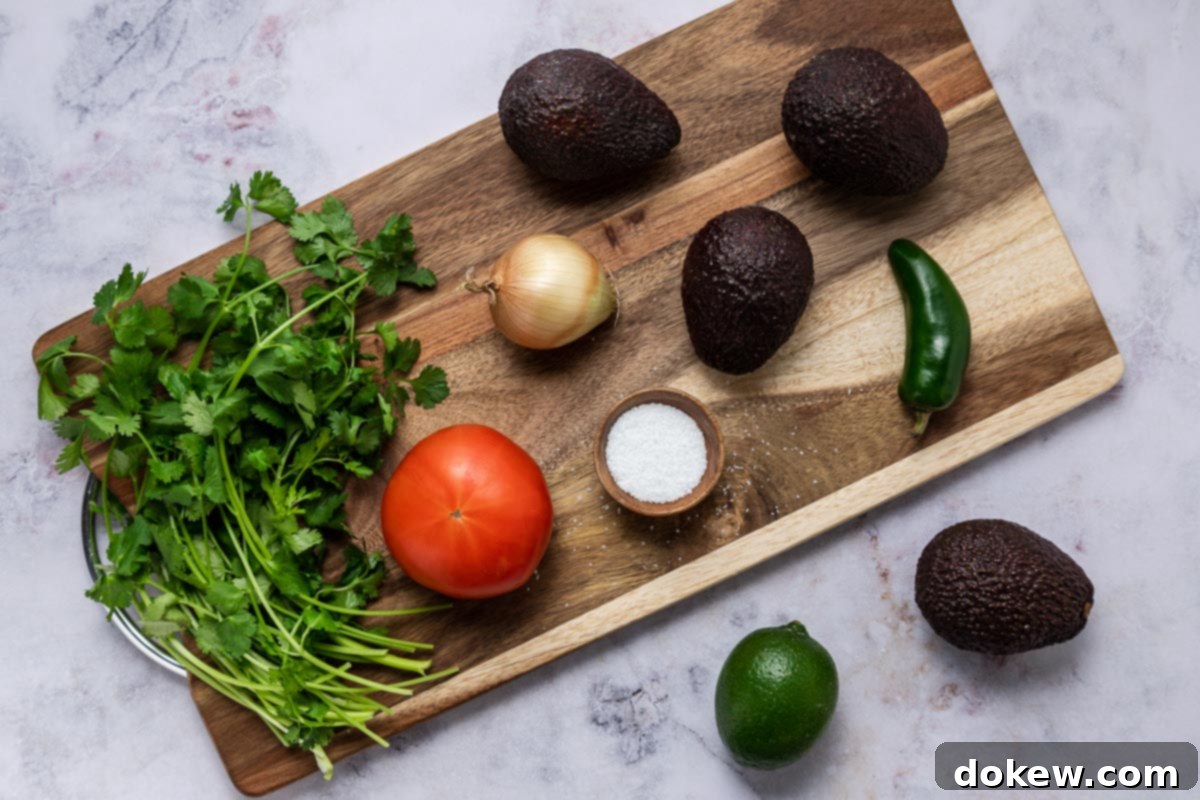
Making homemade guacamole is incredibly simple and satisfying, especially when you use fresh, high-quality ingredients. The process begins with selecting perfectly ripe avocados, which are key to achieving that creamy texture. Once you’ve chosen your avocados, you’ll prepare them by cutting, pitting, and peeling them. After the avocados are ready, they are gently mashed to your desired consistency – some prefer it super smooth, while others love a chunkier texture. Finally, you combine the mashed avocado with the other fresh, finely chopped ingredients like onion, tomato, jalapeño, cilantro, and season it generously with lime juice, lime zest, and salt. The result is a vibrant, flavorful dip without the need for any artificial mixes. Our step-by-step instructions in the recipe card below, complete with helpful images, will guide you through each stage to ensure perfect guacamole every time.
Yes, this recipe embraces the spirit of authentic guacamole by prioritizing fresh ingredients and eschewing pre-made mixes or seasoning packets. The fundamental elements of avocado, onion, tomato, cilantro, lime, and salt are cornerstones of traditional Mexican guacamole. While regional variations certainly exist – some authentic recipes might call for garlic, a different type of chili pepper (like serrano for extra heat), or even a touch of cumin – the essence remains the same: fresh, simple, and flavorful. My personal preference leans towards onion for its crisp bite, but if you enjoy garlic, feel free to add a finely minced clove or two. The beauty of homemade guacamole is that it allows for personal taste adjustments, ensuring it’s perfect for you while staying true to its fresh, unadulterated roots.
Choosing the right avocado is paramount for perfect guacamole. An unripe avocado will be impossible to mash smoothly, while an overripe one can have an unpleasant taste and mushy texture. Here’s how to pick the best ones:
- Feel: For immediate use, an avocado should feel firm but have a slight, gentle give when squeezed lightly in the palm of your hand. Avoid using your fingertips, as this can bruise the fruit. If it’s too soft, it’s likely past its prime. If it’s rock hard, it needs more time to ripen.
- Color: The Hass variety, which is the most common, changes from bright green to a darker, almost purplish-black color as it ripens. However, color isn’t always a foolproof indicator for all avocado varieties, so always combine it with the squeeze test.
- Stem Test: Gently flick off the small stem cap at the top. If it comes off easily and reveals green underneath, the avocado is likely ripe and fresh. If it’s brown, it’s overripe. If it doesn’t come off, it’s probably unripe.
If you plan to use avocados later in the week, it’s perfectly fine to purchase slightly unripe ones (firm with no give). Trying to use an unripe avocado before it’s ready is often an exercise in futility, as it won’t mash properly or have the desired creamy texture.
If you find yourself with unripe avocados but need them ready sooner, there’s a simple trick to hasten the ripening process. Place the avocados in a paper bag, such as a brown paper lunch bag or a grocery bag, and roll down the top to seal it. The paper bag traps the ethylene gas that avocados naturally produce, which is a plant hormone that aids in ripening. Leave the bag at room temperature, ideally on your kitchen counter, and check the avocados daily with a gentle palm squeeze. They usually don’t take long to ripen using this method, often just a day or two. For even faster ripening, you can add an apple or a banana to the bag, as these fruits also release significant amounts of ethylene gas, further accelerating the process.
For the absolute best flavor and freshest appearance, I generally recommend preparing guacamole no more than an hour before serving. Avocados are prone to oxidation, which causes them to turn brown when exposed to air. However, if you absolutely need to prepare parts of it ahead of time, there are strategies. You can prep all the non-avocado ingredients—chopping the onion, tomato, jalapeño, and cilantro, and juicing the lime—up to a day in advance. Store these prepped ingredients separately in airtight containers in the refrigerator. When you’re ready to serve, simply peel, pit, and mash your ripe avocados, then combine them with your prepped ingredients and season with salt. This method minimizes the avocado’s exposure to air and helps maintain its vibrant green color.
Homemade guacamole is truly best enjoyed fresh, ideally within a couple of hours of preparation, as its quality peaks rapidly. Avocados oxidize quickly when exposed to air, leading to browning and a change in texture and flavor. By the second day, even with careful storage, the guacamole will typically start to turn brown, particularly on the surface, and may begin to separate. While it might still be safe to eat, the fresh, vibrant taste and creamy consistency will have noticeably degraded. For optimal enjoyment, plan to consume your homemade guacamole as soon as possible after making it.
Preventing guacamole from turning brown is key to enjoying leftovers, and it primarily involves minimizing exposure to oxygen. Store your guacamole in an airtight container. The most effective methods involve creating a barrier between the guacamole and the air:
- Water Method: Gently press the guacamole down into the container, removing any air pockets. Smooth the surface so it’s flat. Then, carefully pour a thin layer of cold water (about 1/2 inch) over the entire surface of the guacamole, ensuring it’s completely covered. Seal the container with an airtight lid and refrigerate. When ready to serve, simply pour off the water, stir the guacamole, and enjoy.
- Lime Juice/Avocado Oil Method: Similar to the water method, you can use a layer of fresh lime juice or avocado oil to create the barrier. Press the guacamole, smooth the surface, then brush or pour a thin layer of lime juice or avocado oil over it. Lime juice adds more flavor, while avocado oil is neutral. Seal and refrigerate.
- Plastic Wrap Directly on Surface: Place a piece of plastic wrap directly onto the surface of the guacamole, pressing out all air bubbles. Then, seal the container with its lid. This is effective but sometimes less foolproof than the liquid methods.
- Vacuum Sealing: For longer preservation, vacuum sealing works wonders. Special container attachments, like FoodSaver canning jar sealer attachments, can be used to remove air from canning jars, significantly extending freshness and preventing browning for a few days.
When serving leftovers, always remove any liquid or oil from the top. I often reserve this liquid just in case I don’t use all the guacamole and need to re-seal it.
While you technically can freeze guacamole without it “going bad,” it’s generally not recommended due to significant degradation in texture and flavor. The high water content in avocados forms ice crystals when frozen, which then break down the cell walls upon thawing. This results in a much mushier, watery, and less appealing consistency. The vibrant fresh flavors also tend to dull considerably. For these reasons, guacamole is best enjoyed fresh, shortly after it’s made, to appreciate its creamy texture and bright taste to the fullest.
Homemade guacamole is an excellent choice for those following low-carb or ketogenic diets. This specific step-by-step homemade guacamole recipe is very keto-friendly, containing only 2 net carbs per serving. This calculation is based on the recipe yielding 12 servings from 4 medium-sized avocados. Avocados themselves are a fantastic source of healthy fats and fiber, making them naturally low in net carbs. The addition of fresh vegetables like onion, tomato, and jalapeño, along with lime juice and cilantro, keeps the carb count low while boosting flavor and nutrients. It’s a deliciously satisfying and healthy dip that fits perfectly into a low-carb lifestyle.
Guacamole’s versatility extends far beyond just chips! For those avoiding carbs or simply looking for alternatives, there are countless delicious ways to enjoy it:
- Vegetable Sticks: Crisp carrots, celery, bell pepper strips, cucumber slices, or jicama sticks are fantastic dippers.
- Low-Carb Options: Serve with low-carb tortillas (baked into wedges for “chips”), toasted low-carb bread or crackers, or crunchy pork rinds.
- As a Topping: It makes an incredible topping for grilled chicken, fish, steak, scrambled eggs, or omelets.
- In Bowls: Elevate your low-carb Tex-Mex bowls, chili, or salads with a generous dollop of guacamole.
- Stuffed Avocados: Fill the hollow of an avocado half (with the pit removed) with a scoop of guacamole for an extra avocado boost.
- Lettuce Wraps: Use it as a creamy, flavorful spread in lettuce wraps with your favorite protein.
These options ensure you can savor the rich taste of guacamole in many creative and healthy ways.
Guacamole is incredibly versatile and pairs well with a vast array of dishes. Traditionally, it’s a staple for dipping, but it also shines as a topping or side.
- Classic Dippers: Tortilla chips and corn chips are, of course, the quintessential companions for guacamole. Their salty crunch provides a perfect contrast to the creamy dip.
- Low-Carb Alternatives: For guests or personal dietary needs, baked wedges of low-carb tortillas, an assortment of fresh vegetable sticks (like bell peppers, carrots, celery, or cucumber), or even sturdy lettuce cups make excellent substitutes for chips.
- Mexican-Inspired Meals: Guacamole is an indispensable topping for almost any Tex-Mex or Mexican dish. It’s fantastic with tacos (beef, chicken, or fish), tostadas, fajitas (chicken, steak, or veggie), and tortas.
- Grills and BBQs: Serve it alongside grilled meats like steak or chicken, or as a fresh accompaniment to burgers and hot dogs.
- Breakfast and Brunch: A dollop of guacamole can elevate scrambled eggs, omelets, or breakfast burritos.
- Healthy Snacks: Simply spread it on toast (regular or low-carb), rice cakes, or enjoy it straight with a spoon!
Its fresh, creamy, and zesty profile makes it a welcome addition to so many different meals and snack times.
💭 Essential Tips for Guacamole Success
Working with fresh ingredients, especially spicy ones, requires a bit of care. When handling jalapeños or any chili peppers, it’s always wise to wear plastic gloves to protect your hands from the capsaicin, the compound that gives peppers their heat. Even after handling, chili oils can linger on your skin, and inadvertently touching your face, especially your eyes or nose, can cause significant discomfort. If you don’t have disposable gloves readily available, clean grocery store produce bags can be a handy and effective substitute. Simply slip them over your hands while seeding and dicing the peppers, and remember to wash your hands thoroughly with soap and water afterward, even if you wore gloves.
🥑 How to Cut an Avocado Safely and Efficiently
Cutting an avocado might seem straightforward, but a safe and efficient technique ensures you get to the creamy flesh without hassle. Here’s a detailed guide:
- Initial Halving: Place the avocado on a stable cutting board. Carefully cut the avocado in half lengthwise around the pit. Hold the avocado with one hand and slowly rotate it while keeping the knife stationary and cutting all the way until you meet your starting point.
- Twist and Separate: Once you’ve cut all the way around, gently twist the two halves in opposite directions to separate them. One half will have the pit, and the other will be clean.
- Removing the Pit: For the half with the pit, carefully strike the pit with the sharp edge of your knife (the part closest to the handle) so the blade lodges into it. Then, gently twist the knife to dislodge the pit. You can then use a spoon to scoop the pit out of the knife, or carefully push it off with your thumb on the non-sharp side of the blade. Be very cautious during this step.
- Quartering: Take each avocado half and cut it lengthwise again, effectively quartering the avocado. For each cut, guide the knife all the way to the skin. With the avocado lying flat on the cutting board and the knife horizontal and parallel, you can often rotate the avocado carefully while holding the knife in place. If the avocado is perfectly ripe, the knife should glide through with ease.
- Peeling: Now that you have four quarters, peeling each section of avocado is much simpler. Gently peel back the skin from the wider end of each quarter. Ripe avocado skin should come off quite easily.
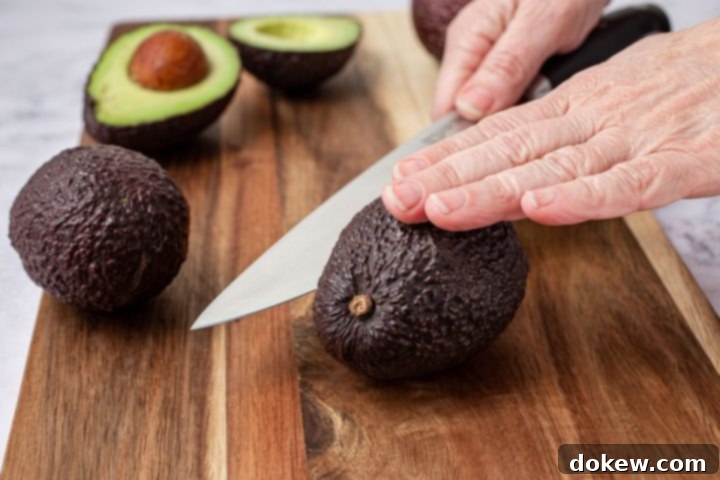
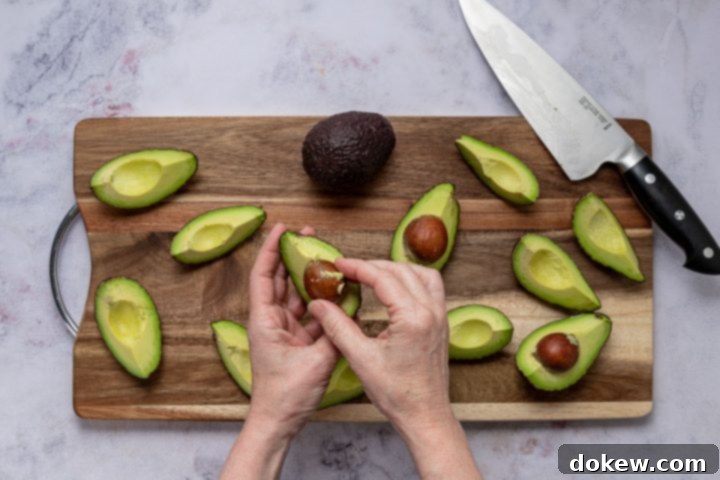
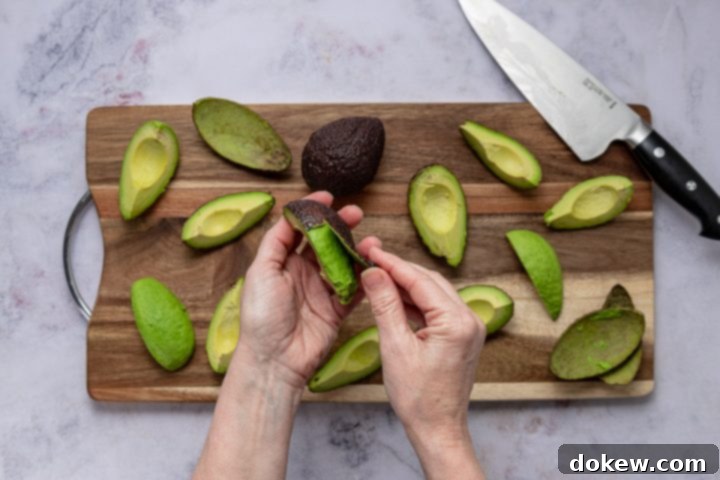
Recipe

Easy Homemade Guacamole Step By Step
Go to Collections
Add to Shopping List
Go to Shopping List
Ingredients
- 4 ripe avocados
- 1 small onion, chopped
- 1 medium tomato, chopped
- 1 jalapeño, seeded and chopped
- 1 teaspoon salt
- 2 tablespoons fresh lime juice
- ½ teaspoon lime zest
- ½ cup fresh cilantro, chopped
Instructions
-
Cut each avocado in half lengthwise, then cut in half lengthwise again. With each cut, take the knife all the way to the pit and, with the avocado on the cutting board and the knife horizontal and parallel to the cutting board, rotate the avocado carefully while holding the knife in place. If the avocado is ripe, it should be fairly easy to cut through.
-
Take the quarters apart and remove the pit by gently twisting with your fingers.
-
Peel each section of avocado.
-
Cube each avocado quarter, place in a medium bowl, and mash gently, leaving some chunks.
-
Add remaining guacamole ingredients and mix thoroughly.
-
Adjust seasonings to taste and serve immediately or refrigerate until ready to use.
Notes
Choosing avocados: For immediate use, avocados should be firm but have some give when you squeeze them gently in the palm of your hand. I usually buy the Hass variety, which turns darker as they ripen (other varieties may not darken with ripeness). The color of this variety in addition to the feel when you give them a gentle squeeze will help you determine the level of ripeness. If you end up with unripe fruit that you need to use, you can hasten ripening by putting them in a paper bag and rolling down the top. Leave them in the bag at room temperature until they ripen, checking them each day with a gentle squeeze.
Nutrition per serving
Carbohydrates: 7 g
Protein: 2 g
Fat: 10 g
Sodium: 200 mg
Fiber: 5 g
Sugar: 1 g
Net Carbohydrates: 2 g
Share
Pin
📌 Pin This Easy Guacamole Recipe!
Loved this recipe? Don’t forget to save it for later! Pin this delicious homemade guacamole recipe to your favorite Pinterest board so you can easily find it whenever you’re craving a fresh, healthy, and flavorful dip. It’s perfect for meal prepping ideas, party appetizers, or a simple snack. Share the goodness with friends and family!
